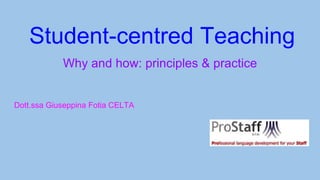
Student centred teaching
- 1. Student-centred Teaching Why and how: principles & practice Dott.ssa Giuseppina Fotia CELTA
- 2. Student-centred lesson Discuss in pairs: ● Which part of the lesson (warmer/lead-in, input, controlled practice, free practice/output) should be student-centred?
- 3. 1) Warmer Wall walk - in pairs, look at the pictures and discuss each picture briefly. ● What’s the role of the teacher in this activity? ● How much is it student-centred? How can you make it more student-centred?
- 4. 1) Warmer - wall walk The teacher ● selects the photos, prints out and puts them up in the classroom ● sets the task ● monitors while sts are discussing the pictures ● asks for feedback The students ● Collaborate with each other ● Are free to express their opinions without worrying too much about accuracy ● Are engaged and led towards the main topic of the lesson ● Are stimulated to know more about the topic (‘What comes next?’)
- 5. 1) Warmers and lead in More student-centred warmers/lead in options: ● Brainstorming ● Find something in common ● Telling each other how they spent the previous weekend ● Speculating about pictures in pairs ● Discussing questions in ‘Starting point’ sessions in pairs ● ...
- 6. 2) Input 1) Any activity Student reads the instructions teacher models the activity and asks CCQs Students peer-check their answers or teacher gives feedback they write the answers on the board 2) Listening tasks: Students check their answers with the script (teacher gives feedback)
- 7. 2) Input 3) Vocabulary Teacher elicits synonyms, L1 equivalent, examples. Students look up the words in the online dictionary or google them, teacher guides the search, students read the definition(s) and the example sentence(s). Students create their own ● Flash cards sets ● Word lists ● ‘Portable dictionaries’
- 8. 3) Controlled practice - gap filling Put the verb in the past tense. 1. She ______________ early. (leave) 2. He ____________ the cake. (make) 3. I ___________ there for six hours. (sit) 4. The man __________ the book. (read) 5. We __________ the homework. (do) 6. The teacher __________ us an exercise. (give) 7. Everyone __________ the movie. (see)
- 9. Alternative, student-centred ways of working on gap filling exercises
- 10. 4) Error correction Peer correction ● check list (writing tasks) ● o/x - tic-tac-toe ● Grammar auction Self correction
- 11. 5) Vocabulary revision 1) Recall & share 2) Stop & go
- 12. 6) revision & personalization
- 13. 6) revision & personalization
- 14. 7) Output Teacher ● Adapts tasks and materials in the SB so that students personalize the TL as much as possible ● Models the activity and asks CCQs ● Monitors Students ● Collaborate in pairs or groups ● Reflect, share and listen ● Correct each other (sometimes)
- 15. 7) Output Speaking activity to revise present perfect and ‘social’ English
- 16. An evergreen:
- 17. 8) Assessment ● Role-play with an odd number of students: 2 students act out, 1 takes note of mistakes/correct TL and assesses the others’ performance. ● Checklists for writing tasks
- 18. Focus is on instructor Focus is on both students and instructor Focus is on language structures and forms (what the instructor knows about language) focus is on language use in situations (how the students can use language in practice) Instructor talks, students listen Instructor models, students interact with instructor and each other Students work alone Students work in pairs, groups or alone depending on the purpose of the activity Instructor monitors and corrects every students ’utterance Students talk without constant instructor monitoring; instructor provides feedback and corrections when questions arise Instructor answers students’ questions about language use Students answer each other’s questions about language using the instructor as a resource Instructor chooses topics Students have some choice of topics Instructor evaluates student learning Students evaluate their own learning; instructor also evaluates Classroom is quiet Classroom is often busy and noisy Teacher-centred Student-centred
- 19. Recommended bibliography https://www.slideshare.net/crlmgn/managing-the-learner-centeredclassroom Penny Ur’s teacher training course: ‘Learning to teach (better)’ J. Harmer The Practice of English Language Teaching - chapters 4 and 22
- 20. … to conclude: TEACH THE STUDENT(S), NOT THE LESSON PLAN!
